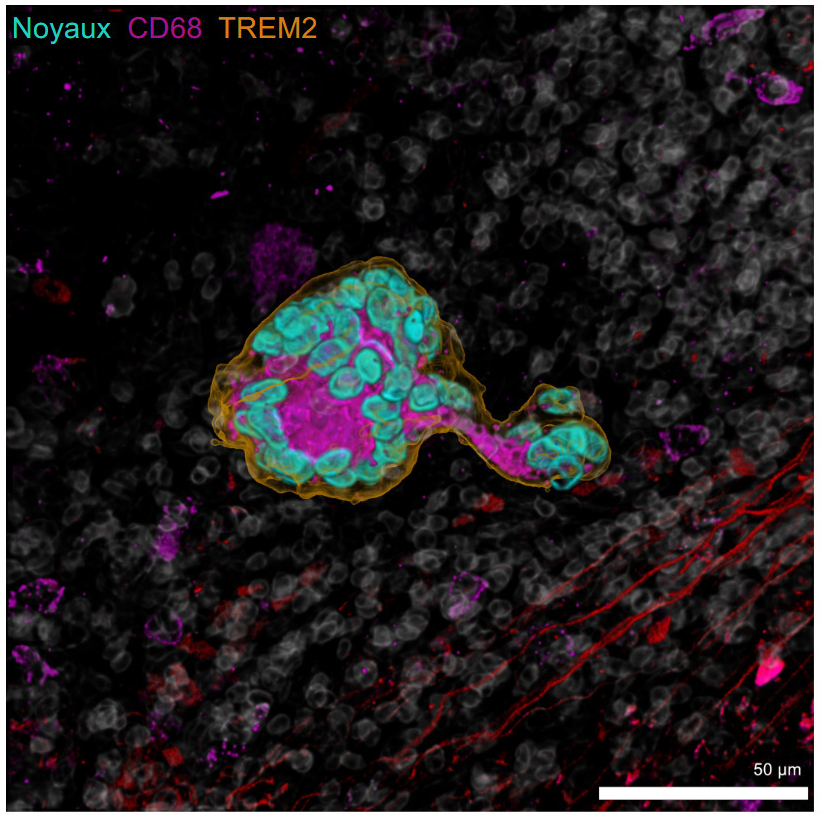Villejuif, November 6, 2024
Cancer discovery
Discovery of a new prognostic biomarker in head and neck squamous cell carcinomas
Until now, TREM2-expressing macrophages in a tumor were associated with a poor prognosis. Research conducted within Professor Florent Ginhoux's lab at Gustave Roussy, led by pathology resident Grégoire Gessain, shows that in head and neck squamous cell carcinomas (HNSCC), the presence of a specific type of immune cell—giant TREM2-expressing macrophages—is a marker of good prognosis. This new biomarker could assist oncologists in personalizing patient care.

A multinucleated giant macrophage
Online article: https://aacrjournals.org/cancerdiscovery/article/doi/10.1158/2159-8290.CD-24-0018/749302/TREM2-Expressing-Multinucleated-Giant-Macrophages
Squamous cell carcinomas (SCC) are among the most common cancers affecting various organs. They account for approximately 90% of head and neck cancers, originating from mucous membranes in areas such as the mouth, tonsils, pharynx, and larynx. In 2020, 890,000 new head and neck SCC (HNSCC) cases were reported globally, with incidence rates on the rise. By 2030, it is estimated that there will be 1.08 million new cases annually. About 50% of patients with this condition experience recurrence or distant metastasis within three years of diagnosis, highlighting the need for new prognostic biomarkers to guide treatment decisions more effectively.
Grégoire Gessain explains: “During my ENT pathology residency at Gustave Roussy, I treated numerous patients with head and neck squamous cell carcinoma. Microscopic analysis of their biopsy samples often revealed large, easily identifiable multinucleated giant cells. Until now, no study has explored whether their presence affected patient prognosis. This is how our research project began, bringing together various specialties at Gustave Roussy—pathologists, surgeons, and immunologists—which allowed us to conduct substantial translational research.”
A Good Prognostic Score
Multinucleated giant cells result from the fusion of monocytes and macrophages, which are immune system cells. These giant cells form in response to keratin produced uncontrollably by cancer cells, which they then phagocytose (ingest and break down).
The study published in Cancer Discovery shows that the abundance of multinucleated giant cells in HNSCC is a favorable prognostic biomarker. To reach this conclusion, researchers examined two cohorts comprising a total of 394 patients with this condition. They found that keratinizing tumors often contain multinucleated giant cells, though only a third present a high density of them. The 394 patients were then divided into three risk groups based on the density of multinucleated giant cells in their tumors.
Results indicated that higher levels of multinucleated giant cells correlate with improved overall survival and longer progression-free survival. These findings were independent of factors such as gender, age, disease stage, smoking, and alcohol consumption.
The Role of Artificial Intelligence
Following these initial findings obtained through manual cell counting, researchers developed an algorithm to detect and quantify multinucleated giant cells in patient histological slides using artificial intelligence. This algorithm automatically identifies tumor and giant cells, generating a score to stratify patients into risk groups. Results were comparable to those calculated by pathologists but were obtained much more quickly.
Artificial intelligence enabled researchers to extend these findings to other non-head and neck squamous cell carcinomas. Analyses in cervical squamous cell carcinoma confirmed the impact of giant cell density on prognosis. The next step will involve studying squamous cell carcinomas in the lung, esophagus, and skin.
Comprehensive Cell Characterization
Research led at Professor Florent Ginhoux’s Gustave Roussy/Inserm lab enabled the biological characterization of these multinucleated giant cells, marking a scientific first, as their large size makes them challenging to analyze with standard equipment like flow cytometers or SingleCell platforms.
“Using spatial transcriptomics, an advanced technology that allows cell characterization directly in their tumor microenvironment on histology slides, we confirmed the macrophagic nature of multinucleated giant cells. These cells express TREM2, a membrane protein that promotes phagocytosis,” explains Professor Florent Ginhoux.
Previous studies suggested that the presence of TREM2-expressing macrophages in the tumor environment was a poor prognostic biomarker. “No one had yet examined the relationship between these cells and the specific cancer types they inhabit. We show that TREM2-expressing macrophages are a favorable prognostic biomarker in squamous cell carcinomas, while their prognostic value is completely reversed in most adenocarcinomas” notes Grégoire Gessain.
The next step will be to validate the biomarker’s prognostic value in cohorts from other centers across France and internationally, and then determine its clinical application. “Finding a reliable and reproducible prognostic biomarker is essential in oncology. It helps clinicians stratify patients by risk and tailor treatments accordingly—for instance, reducing intensity and toxicity for low-risk patients or intensifying treatments for high-risk patients to improve cure rates. It also aids in selecting patients for future clinical trials” concludes Dr. Philippe Gorphe, ENT surgeon at Gustave Roussy. This research was supported by the INCa-DGOS (PRT-K) translational cancer research program.
Source
Cancer discovery
Trem2-expressing multinucleated giant macrophages are a biomarker of good prognosis in head and neck squamous cell carcinoma
Early online publication: September 16, 2024
DOI : 10.1158/2159-8290.CD-24-0018
Authors: Gregoire Gessain, Ahmed-Amine Anzali, Marvin Lerousseau, Kevin Mulder, Mathilde Bied, Anne Auperin, Daniel Stockholm, Nicolas Signolle, Farah Sassi, Maria Eugenia Marques Da Costa, Antonin Marchais, Alexandre Sayadi, Daniela Weidner, Stefan Uderhardt, Quentin Blampey, Sumanth Reddy Nakkireddy, Sophie Broutin, Charles-Antoine Dutertre, Pierre Busson, Thomas Walter, Alix Marhic, Antoine Moya-Plana, Joanne Guerlain, Ingrid Breuskin, Odile Casiraghi, Philippe Gorphe, Marion Classe, Jean-Yves Scoazec, Camille Bleriot, Florent Ginhoux.
